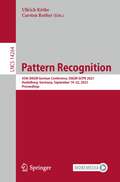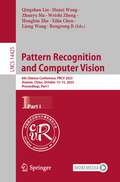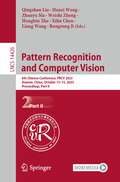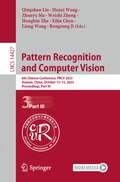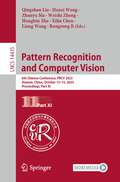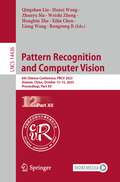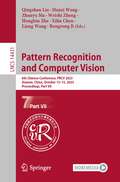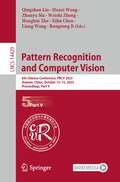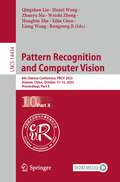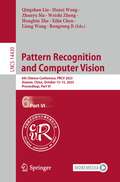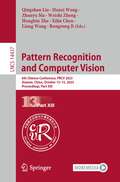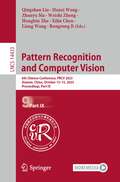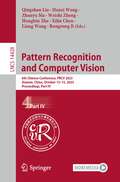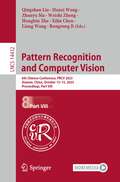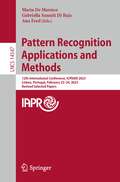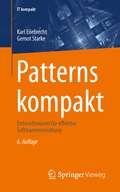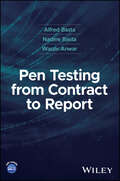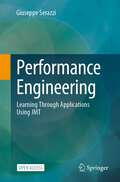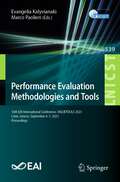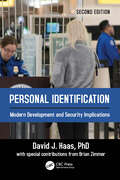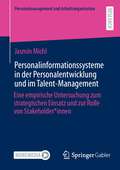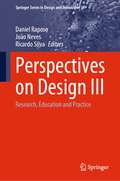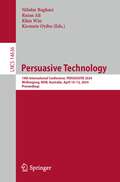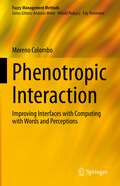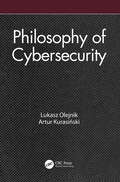- Table View
- List View
Pattern Recognition: 45th DAGM German Conference, DAGM GCPR 2023, Heidelberg, Germany, September 19–22, 2023, Proceedings (Lecture Notes in Computer Science #14264)
by Ullrich Köthe Carsten RotherThis book constitutes the proceedings of the 45th Annual Conference of the German Association for Pattern Recognition, DAGM-GCPR 2023, which took place in Heidelberg, Germany, during September 19-22, 2023. The 40 full papers included in these proceedings were carefully reviewed and selected from 76 submissions. They were organized in topical sections as follows: Segmentation and action recognition; 3D reconstruction and neural rendering; Photogrammetry and remote sensing; Pattern recognition in the life sciences; Interpretable machine learning; Weak supervision and online learning; Robust models.
Pattern Recognition and Computer Vision: 6th Chinese Conference, PRCV 2023, Xiamen, China, October 13–15, 2023, Proceedings, Part I (Lecture Notes in Computer Science #14425)
by Qingshan Liu Hanzi Wang Zhanyu Ma Weishi Zheng Hongbin Zha Xilin Chen Liang Wang Rongrong JiThe 13-volume set LNCS 14425-14437 constitutes the refereed proceedings of the 6th Chinese Conference on Pattern Recognition and Computer Vision, PRCV 2023, held in Xiamen, China, during October 13–15, 2023. The 532 full papers presented in these volumes were selected from 1420 submissions. The papers have been organized in the following topical sections: Action Recognition, Multi-Modal Information Processing, 3D Vision and Reconstruction, Character Recognition, Fundamental Theory of Computer Vision, Machine Learning, Vision Problems in Robotics, Autonomous Driving, Pattern Classification and Cluster Analysis, Performance Evaluation and Benchmarks, Remote Sensing Image Interpretation, Biometric Recognition, Face Recognition and Pose Recognition, Structural Pattern Recognition, Computational Photography, Sensing and Display Technology, Video Analysis and Understanding, Vision Applications and Systems, Document Analysis and Recognition, Feature Extraction and Feature Selection, Multimedia Analysis and Reasoning, Optimization and Learning methods, Neural Network and Deep Learning, Low-Level Vision and Image Processing, Object Detection, Tracking and Identification, Medical Image Processing and Analysis.
Pattern Recognition and Computer Vision: 6th Chinese Conference, PRCV 2023, Xiamen, China, October 13–15, 2023, Proceedings, Part II (Lecture Notes in Computer Science #14426)
by Qingshan Liu Hanzi Wang Zhanyu Ma Weishi Zheng Hongbin Zha Xilin Chen Liang Wang Rongrong JiThe 13-volume set LNCS 14425-14437 constitutes the refereed proceedings of the 6th Chinese Conference on Pattern Recognition and Computer Vision, PRCV 2023, held in Xiamen, China, during October 13–15, 2023. The 532 full papers presented in these volumes were selected from 1420 submissions. The papers have been organized in the following topical sections: Action Recognition, Multi-Modal Information Processing, 3D Vision and Reconstruction, Character Recognition, Fundamental Theory of Computer Vision, Machine Learning, Vision Problems in Robotics, Autonomous Driving, Pattern Classification and Cluster Analysis, Performance Evaluation and Benchmarks, Remote Sensing Image Interpretation, Biometric Recognition, Face Recognition and Pose Recognition, Structural Pattern Recognition, Computational Photography, Sensing and Display Technology, Video Analysis and Understanding, Vision Applications and Systems, Document Analysis and Recognition, Feature Extraction and Feature Selection, Multimedia Analysis and Reasoning, Optimization and Learning methods, Neural Network and Deep Learning, Low-Level Vision and Image Processing, Object Detection, Tracking and Identification, Medical Image Processing and Analysis.
Pattern Recognition and Computer Vision: 6th Chinese Conference, PRCV 2023, Xiamen, China, October 13–15, 2023, Proceedings, Part III (Lecture Notes in Computer Science #14427)
by Qingshan Liu Hanzi Wang Zhanyu Ma Weishi Zheng Hongbin Zha Xilin Chen Liang Wang Rongrong JiThe 13-volume set LNCS 14425-14437 constitutes the refereed proceedings of the 6th Chinese Conference on Pattern Recognition and Computer Vision, PRCV 2023, held in Xiamen, China, during October 13–15, 2023. The 532 full papers presented in these volumes were selected from 1420 submissions. The papers have been organized in the following topical sections: Action Recognition, Multi-Modal Information Processing, 3D Vision and Reconstruction, Character Recognition, Fundamental Theory of Computer Vision, Machine Learning, Vision Problems in Robotics, Autonomous Driving, Pattern Classification and Cluster Analysis, Performance Evaluation and Benchmarks, Remote Sensing Image Interpretation, Biometric Recognition, Face Recognition and Pose Recognition, Structural Pattern Recognition, Computational Photography, Sensing and Display Technology, Video Analysis and Understanding, Vision Applications and Systems, Document Analysis and Recognition, Feature Extraction and Feature Selection, Multimedia Analysis and Reasoning, Optimization and Learning methods, Neural Network and Deep Learning, Low-Level Vision and Image Processing, Object Detection, Tracking and Identification, Medical Image Processing and Analysis.
Pattern Recognition and Computer Vision: 6th Chinese Conference, PRCV 2023, Xiamen, China, October 13–15, 2023, Proceedings, Part XI (Lecture Notes in Computer Science #14435)
by Qingshan Liu Hanzi Wang Zhanyu Ma Weishi Zheng Hongbin Zha Xilin Chen Liang Wang Rongrong JiThe 13-volume set LNCS 14425-14437 constitutes the refereed proceedings of the 6th Chinese Conference on Pattern Recognition and Computer Vision, PRCV 2023, held in Xiamen, China, during October 13–15, 2023. The 532 full papers presented in these volumes were selected from 1420 submissions. The papers have been organized in the following topical sections: Action Recognition, Multi-Modal Information Processing, 3D Vision and Reconstruction, Character Recognition, Fundamental Theory of Computer Vision, Machine Learning, Vision Problems in Robotics, Autonomous Driving, Pattern Classification and Cluster Analysis, Performance Evaluation and Benchmarks, Remote Sensing Image Interpretation, Biometric Recognition, Face Recognition and Pose Recognition, Structural Pattern Recognition, Computational Photography, Sensing and Display Technology, Video Analysis and Understanding, Vision Applications and Systems, Document Analysis and Recognition, Feature Extraction and Feature Selection, Multimedia Analysis and Reasoning, Optimization and Learning methods, Neural Network and Deep Learning, Low-Level Vision and Image Processing, Object Detection, Tracking and Identification, Medical Image Processing and Analysis.
Pattern Recognition and Computer Vision: 6th Chinese Conference, PRCV 2023, Xiamen, China, October 13–15, 2023, Proceedings, Part XII (Lecture Notes in Computer Science #14436)
by Qingshan Liu Hanzi Wang Zhanyu Ma Weishi Zheng Hongbin Zha Xilin Chen Liang Wang Rongrong JiThe 13-volume set LNCS 14425-14437 constitutes the refereed proceedings of the 6th Chinese Conference on Pattern Recognition and Computer Vision, PRCV 2023, held in Xiamen, China, during October 13–15, 2023. The 532 full papers presented in these volumes were selected from 1420 submissions. The papers have been organized in the following topical sections: Action Recognition, Multi-Modal Information Processing, 3D Vision and Reconstruction, Character Recognition, Fundamental Theory of Computer Vision, Machine Learning, Vision Problems in Robotics, Autonomous Driving, Pattern Classification and Cluster Analysis, Performance Evaluation and Benchmarks, Remote Sensing Image Interpretation, Biometric Recognition, Face Recognition and Pose Recognition, Structural Pattern Recognition, Computational Photography, Sensing and Display Technology, Video Analysis and Understanding, Vision Applications and Systems, Document Analysis and Recognition, Feature Extraction and Feature Selection, Multimedia Analysis and Reasoning, Optimization and Learning methods, Neural Network and Deep Learning, Low-Level Vision and Image Processing, Object Detection, Tracking and Identification, Medical Image Processing and Analysis.
Pattern Recognition and Computer Vision: 6th Chinese Conference, PRCV 2023, Xiamen, China, October 13–15, 2023, Proceedings, Part VII (Lecture Notes in Computer Science #14431)
by Qingshan Liu Hanzi Wang Zhanyu Ma Weishi Zheng Hongbin Zha Xilin Chen Liang Wang Rongrong JiThe 13-volume set LNCS 14425-14437 constitutes the refereed proceedings of the 6th Chinese Conference on Pattern Recognition and Computer Vision, PRCV 2023, held in Xiamen, China, during October 13–15, 2023. The 532 full papers presented in these volumes were selected from 1420 submissions. The papers have been organized in the following topical sections: Action Recognition, Multi-Modal Information Processing, 3D Vision and Reconstruction, Character Recognition, Fundamental Theory of Computer Vision, Machine Learning, Vision Problems in Robotics, Autonomous Driving, Pattern Classification and Cluster Analysis, Performance Evaluation and Benchmarks, Remote Sensing Image Interpretation, Biometric Recognition, Face Recognition and Pose Recognition, Structural Pattern Recognition, Computational Photography, Sensing and Display Technology, Video Analysis and Understanding, Vision Applications and Systems, Document Analysis and Recognition, Feature Extraction and Feature Selection, Multimedia Analysis and Reasoning, Optimization and Learning methods, Neural Network and Deep Learning, Low-Level Vision and Image Processing, Object Detection, Tracking and Identification, Medical Image Processing and Analysis.
Pattern Recognition and Computer Vision: 6th Chinese Conference, PRCV 2023, Xiamen, China, October 13–15, 2023, Proceedings, Part V (Lecture Notes in Computer Science #14429)
by Qingshan Liu Hanzi Wang Zhanyu Ma Weishi Zheng Hongbin Zha Xilin Chen Liang Wang Rongrong JiThe 13-volume set LNCS 14425-14437 constitutes the refereed proceedings of the 6th Chinese Conference on Pattern Recognition and Computer Vision, PRCV 2023, held in Xiamen, China, during October 13–15, 2023. The 532 full papers presented in these volumes were selected from 1420 submissions. The papers have been organized in the following topical sections: Action Recognition, Multi-Modal Information Processing, 3D Vision and Reconstruction, Character Recognition, Fundamental Theory of Computer Vision, Machine Learning, Vision Problems in Robotics, Autonomous Driving, Pattern Classification and Cluster Analysis, Performance Evaluation and Benchmarks, Remote Sensing Image Interpretation, Biometric Recognition, Face Recognition and Pose Recognition, Structural Pattern Recognition, Computational Photography, Sensing and Display Technology, Video Analysis and Understanding, Vision Applications and Systems, Document Analysis and Recognition, Feature Extraction and Feature Selection, Multimedia Analysis and Reasoning, Optimization and Learning methods, Neural Network and Deep Learning, Low-Level Vision and Image Processing, Object Detection, Tracking and Identification, Medical Image Processing and Analysis.
Pattern Recognition and Computer Vision: 6th Chinese Conference, PRCV 2023, Xiamen, China, October 13–15, 2023, Proceedings, Part X (Lecture Notes in Computer Science #14434)
by Qingshan Liu Hanzi Wang Zhanyu Ma Weishi Zheng Hongbin Zha Xilin Chen Liang Wang Rongrong JiThe 13-volume set LNCS 14425-14437 constitutes the refereed proceedings of the 6th Chinese Conference on Pattern Recognition and Computer Vision, PRCV 2023, held in Xiamen, China, during October 13–15, 2023. The 532 full papers presented in these volumes were selected from 1420 submissions. The papers have been organized in the following topical sections: Action Recognition, Multi-Modal Information Processing, 3D Vision and Reconstruction, Character Recognition, Fundamental Theory of Computer Vision, Machine Learning, Vision Problems in Robotics, Autonomous Driving, Pattern Classification and Cluster Analysis, Performance Evaluation and Benchmarks, Remote Sensing Image Interpretation, Biometric Recognition, Face Recognition and Pose Recognition, Structural Pattern Recognition, Computational Photography, Sensing and Display Technology, Video Analysis and Understanding, Vision Applications and Systems, Document Analysis and Recognition, Feature Extraction and Feature Selection, Multimedia Analysis and Reasoning, Optimization and Learning methods, Neural Network and Deep Learning, Low-Level Vision and Image Processing, Object Detection, Tracking and Identification, Medical Image Processing and Analysis.
Pattern Recognition and Computer Vision: 6th Chinese Conference, PRCV 2023, Xiamen, China, October 13–15, 2023, Proceedings, Part VI (Lecture Notes in Computer Science #14430)
by Qingshan Liu Hanzi Wang Zhanyu Ma Weishi Zheng Hongbin Zha Xilin Chen Liang Wang Rongrong JiThe 13-volume set LNCS 14425-14437 constitutes the refereed proceedings of the 6th Chinese Conference on Pattern Recognition and Computer Vision, PRCV 2023, held in Xiamen, China, during October 13–15, 2023. The 532 full papers presented in these volumes were selected from 1420 submissions. The papers have been organized in the following topical sections: Action Recognition, Multi-Modal Information Processing, 3D Vision and Reconstruction, Character Recognition, Fundamental Theory of Computer Vision, Machine Learning, Vision Problems in Robotics, Autonomous Driving, Pattern Classification and Cluster Analysis, Performance Evaluation and Benchmarks, Remote Sensing Image Interpretation, Biometric Recognition, Face Recognition and Pose Recognition, Structural Pattern Recognition, Computational Photography, Sensing and Display Technology, Video Analysis and Understanding, Vision Applications and Systems, Document Analysis and Recognition, Feature Extraction and Feature Selection, Multimedia Analysis and Reasoning, Optimization and Learning methods, Neural Network and Deep Learning, Low-Level Vision and Image Processing, Object Detection, Tracking and Identification, Medical Image Processing and Analysis.
Pattern Recognition and Computer Vision: 6th Chinese Conference, PRCV 2023, Xiamen, China, October 13–15, 2023, Proceedings, Part XIII (Lecture Notes in Computer Science #14437)
by Qingshan Liu Hanzi Wang Zhanyu Ma Weishi Zheng Hongbin Zha Xilin Chen Liang Wang Rongrong JiThe 13-volume set LNCS 14425-14437 constitutes the refereed proceedings of the 6th Chinese Conference on Pattern Recognition and Computer Vision, PRCV 2023, held in Xiamen, China, during October 13–15, 2023. The 532 full papers presented in these volumes were selected from 1420 submissions. The papers have been organized in the following topical sections: Action Recognition, Multi-Modal Information Processing, 3D Vision and Reconstruction, Character Recognition, Fundamental Theory of Computer Vision, Machine Learning, Vision Problems in Robotics, Autonomous Driving, Pattern Classification and Cluster Analysis, Performance Evaluation and Benchmarks, Remote Sensing Image Interpretation, Biometric Recognition, Face Recognition and Pose Recognition, Structural Pattern Recognition, Computational Photography, Sensing and Display Technology, Video Analysis and Understanding, Vision Applications and Systems, Document Analysis and Recognition, Feature Extraction and Feature Selection, Multimedia Analysis and Reasoning, Optimization and Learning methods, Neural Network and Deep Learning, Low-Level Vision and Image Processing, Object Detection, Tracking and Identification, Medical Image Processing and Analysis.
Pattern Recognition and Computer Vision: 6th Chinese Conference, PRCV 2023, Xiamen, China, October 13–15, 2023, Proceedings, Part IX (Lecture Notes in Computer Science #14433)
by Qingshan Liu Hanzi Wang Zhanyu Ma Weishi Zheng Hongbin Zha Xilin Chen Liang Wang Rongrong JiThe 13-volume set LNCS 14425-14437 constitutes the refereed proceedings of the 6th Chinese Conference on Pattern Recognition and Computer Vision, PRCV 2023, held in Xiamen, China, during October 13–15, 2023. The 532 full papers presented in these volumes were selected from 1420 submissions. The papers have been organized in the following topical sections: Action Recognition, Multi-Modal Information Processing, 3D Vision and Reconstruction, Character Recognition, Fundamental Theory of Computer Vision, Machine Learning, Vision Problems in Robotics, Autonomous Driving, Pattern Classification and Cluster Analysis, Performance Evaluation and Benchmarks, Remote Sensing Image Interpretation, Biometric Recognition, Face Recognition and Pose Recognition, Structural Pattern Recognition, Computational Photography, Sensing and Display Technology, Video Analysis and Understanding, Vision Applications and Systems, Document Analysis and Recognition, Feature Extraction and Feature Selection, Multimedia Analysis and Reasoning, Optimization and Learning methods, Neural Network and Deep Learning, Low-Level Vision and Image Processing, Object Detection, Tracking and Identification, Medical Image Processing and Analysis.
Pattern Recognition and Computer Vision: 6th Chinese Conference, PRCV 2023, Xiamen, China, October 13–15, 2023, Proceedings, Part IV (Lecture Notes in Computer Science #14428)
by Qingshan Liu Hanzi Wang Zhanyu Ma Weishi Zheng Hongbin Zha Xilin Chen Liang Wang Rongrong JiThe 13-volume set LNCS 14425-14437 constitutes the refereed proceedings of the 6th Chinese Conference on Pattern Recognition and Computer Vision, PRCV 2023, held in Xiamen, China, during October 13–15, 2023. The 532 full papers presented in these volumes were selected from 1420 submissions. The papers have been organized in the following topical sections: Action Recognition, Multi-Modal Information Processing, 3D Vision and Reconstruction, Character Recognition, Fundamental Theory of Computer Vision, Machine Learning, Vision Problems in Robotics, Autonomous Driving, Pattern Classification and Cluster Analysis, Performance Evaluation and Benchmarks, Remote Sensing Image Interpretation, Biometric Recognition, Face Recognition and Pose Recognition, Structural Pattern Recognition, Computational Photography, Sensing and Display Technology, Video Analysis and Understanding, Vision Applications and Systems, Document Analysis and Recognition, Feature Extraction and Feature Selection, Multimedia Analysis and Reasoning, Optimization and Learning methods, Neural Network and Deep Learning, Low-Level Vision and Image Processing, Object Detection, Tracking and Identification, Medical Image Processing and Analysis
Pattern Recognition and Computer Vision: 6th Chinese Conference, PRCV 2023, Xiamen, China, October 13–15, 2023, Proceedings, Part VIII (Lecture Notes in Computer Science #14432)
by Qingshan Liu Hanzi Wang Zhanyu Ma Weishi Zheng Hongbin Zha Xilin Chen Liang Wang Rongrong JiThe 13-volume set LNCS 14425-14437 constitutes the refereed proceedings of the 6th Chinese Conference on Pattern Recognition and Computer Vision, PRCV 2023, held in Xiamen, China, during October 13–15, 2023. The 532 full papers presented in these volumes were selected from 1420 submissions. The papers have been organized in the following topical sections: Action Recognition, Multi-Modal Information Processing, 3D Vision and Reconstruction, Character Recognition, Fundamental Theory of Computer Vision, Machine Learning, Vision Problems in Robotics, Autonomous Driving, Pattern Classification and Cluster Analysis, Performance Evaluation and Benchmarks, Remote Sensing Image Interpretation, Biometric Recognition, Face Recognition and Pose Recognition, Structural Pattern Recognition, Computational Photography, Sensing and Display Technology, Video Analysis and Understanding, Vision Applications and Systems, Document Analysis and Recognition, Feature Extraction and Feature Selection, Multimedia Analysis and Reasoning, Optimization and Learning methods, Neural Network and Deep Learning, Low-Level Vision and Image Processing, Object Detection, Tracking and Identification, Medical Image Processing and Analysis.
Pattern Recognition Applications and Methods: 12th International Conference, ICPRAM 2023, Lisbon, Portugal, February 22–24, 2023, Revised Selected Papers (Lecture Notes in Computer Science #14547)
by Maria De Marsico Gabriella Sanniti Di Baja Ana FredThis book constitutes the thoroughly refereed and revised selected papers from the 12th International Conference on Pattern Recognition Applications and Methods, ICPRAM 2023, held in Lisbon, Portugal, during February 22–24, 2023. The 28 full papers and 42 short papers included in this book were carefully reviewed and selected from 157 submissions. They were organized in topical sections as follows: theory and methods and applications.
Patterns kompakt: Entwurfsmuster für effektive Softwareentwicklung (IT kompakt)
by Karl Eilebrecht Gernot StarkePatterns kompakt fasst die wichtigsten Entwurfsmuster zusammen, die Sie für Softwareentwicklung benötigen. Sie finden praxisnahe und effektiv anwendbare Lösungen für typische Entwurfsprobleme.Das Buch gliedert Patterns anhand typischer Aspekte des Softwareentwurfs: Basismuster für mehr Flexibilität und WartbarkeitPräsentationKommunikation und VerteilungIntegrationPersistenzDie sechste aktualisierte und erweiterte Auflage erklärt darüber hinaus weitere Musterkategorien.Patterns kompakt unterstützt mit praktischen Tipps zur Softwareentwicklung und -architektur und gibt einen praxisorientierten Überblick zu wesentlichen Entwurfsmustern.
Pen Testing from Contract to Report
by Alfred Basta Nadine Basta Waqar AnwarPen Testing from Contractto Report Protect your system or web application with this accessible guide Penetration tests, also known as ‘pen tests’, are a means of assessing the security of a computer system by simulating a cyber-attack. These tests can be an essential tool in detecting exploitable vulnerabilities in a computer system or web application, averting potential user data breaches, privacy violations, losses of system function, and more. With system security an increasingly fundamental part of a connected world, it has never been more important that cyber professionals understand the pen test and its potential applications. Pen Testing from Contract to Report offers a step-by-step overview of the subject. Built around a new concept called the Penetration Testing Life Cycle, it breaks the process into phases, guiding the reader through each phase and its potential to expose and address system vulnerabilities. The result is an essential tool in the ongoing fight against harmful system intrusions. In Pen Testing from Contract to Report readers will also find: Content mapped to certification exams such as the CompTIA PenTest+Detailed techniques for evading intrusion detection systems, firewalls, honeypots, and moreAccompanying software designed to enable the reader to practice the concepts outlined, as well as end-of-chapter questions and case studies Pen Testing from Contract to Report is ideal for any cyber security professional or advanced student of cyber security.
Performance Engineering: Learning Through Applications Using JMT
by Giuseppe SerazziThis open access book improves the users' skills needed to implement models for performance evaluation of digital infrastructures. Building a model is usually a relatively easy task, but making it an accurate representation of the phenomenon to be reproduced is a completely different matter. It is well-known that to increase the ability to build reliable models it is necessary to accumulate experience. The book addresses this need by presenting a collection of case studies of increasing complexity. Readers are introduced to the modeling process gradually, learning the basic concepts step-by-step as they go through the case studies. Queueing Networks are used to design the models solved with simulation and analytical techniques from the open source Java Modelling Tools (JMT). Among the models analyzed there are systems for optimizing performance, identifying bottlenecks, evaluating the impact of the variability of traffic and service demands, analyzing the effects of synchronization policies in parallel computing. Four case studies derived from real-life scenarios are also presented: a surveillance system, autoscaling load fluctuations, web app workflow simulation, and crowd computing platform. This book serves as a reference tool for graduate and senior-level computer science students in courses of performance evaluation and modeling, as well as for researchers and practitioners.
Performance Evaluation Methodologies and Tools: 16th EAI International Conference, VALUETOOLS 2023, Crete, Greece, September 6–7, 2023, Proceedings (Lecture Notes of the Institute for Computer Sciences, Social Informatics and Telecommunications Engineering #539)
by Evangelia Kalyvianaki Marco PaolieriThis volume contains the proceedings of the 16th EAI International Conference on Performance Evaluation Methodologies and Tools, VALUETOOLS 2023, which took place in Heraklion, Crete during September 6-7, 2023. The conference brought together researchers, developers, and practitioners from around the world and from different communities including computer science, networks and telecommunications, operations research, optimization, control theory, and manufacturing. The 27 members of the International Program Committee (PC) helped to provide at least 3 reviews for each of the 30 submitted contributions. Based on the reviews and PC discussions, 11 high-quality papers (9 research papers, 1 tool paper, and 1 work-in-progress paper) were accepted to be presented during the conference. The volume includes contributions organized into four thematic sessions: Games and Optimization; Simulation; Networking and Queues; Tools.
Personal Identification: Modern Development and Security Implications
by David J. HaasPersonal Identification: Modern Development and Security Implications, Second Edition explains how personal identification – and REAL ID – became part of the American fabric along with their past century’s historical ID development. The development of the “trusted and secure” personal identification documents began with passports and has continued as social changes made IDs more essential. This book describes the convergence of technologies and hundreds of patents that produced our “trusted and secure” documents and IDs from our past right up through to today.Key factors, that created today’s need for public-issued mass ID, are addressed: Chronicles the effects of large and mobile populations beginning a century ago Chronicles the effects of “impersonal” electronic & computer communications at a distance, and not face-to-face The distribution of services and money by government agencies based on a person’s identity – including “age” and “group” criteria Describes recent national security and terrorism concerns that necessitates the need to know: “You are who you say you are.” Personal identification documents (IDs) and the societal need for “trusted” identification by the public is a relatively new social phenomenon. In 1900, most people did not need or have any IDs until passports, with a photograph of the individual, became mandatory when Great Britain entered World War I in 1914. In the United States, the State-issued driver’s license is probably the only trusted ID in one’s wallet today, but they became “trusted and secure” documents only recently with the requirement for REAL ID. With the first photo driver’s license issued by the State of Colorado in 1959, it took until 1984 for the last State (New York, 25 years later) to comply.As a direct result of 9/11, where terrorists used fake driver’s licenses to board planes, Congress passed the Real ID Act in 2005 to make all State-issued driver’s licenses more trusted, uniform, and tamper-resistant – what is now called the Enhanced Driver’s License with non-drivers being issued Enhanced Identification Cards. And with this, every US citizen can now possess a trusted and secure personal identification document.Personal Identification, Second Edition chronicles the path of personal identification measures – including the latest developments of Real ID. Scholars and professional security managers understand that stability, security, and safety necessitate these identity measures to ensure a safer America. The book explains the various stages and advances, providing readers with a unique study of this fascinating history of the relationship between identity and the means by which one validates and proves their own identity. The enactment of the REAL ID Act of 2005, with more secure and tamper-resistant documents for each citizen of the United States, is being instituted so that one can trust: “you are who you say you are.” The State-issued driver’s license is not a National ID Card – it is a Nationally Recognized ID for each citizen.
Personalinformationssysteme in der Personalentwicklung und im Talent-Management: Eine empirische Untersuchung zum strategischen Einsatz und zur Rolle von Stakeholder*innen (Personalmanagement und Arbeitsorganisation)
by Jasmin MichlJasmin Michl realisiert eine tiefgehende Untersuchung zum Einsatz von Personalinformationssystemen in der Personalentwicklung und im Talent-Management mit besonderem Fokus auf strategische Einsatzgebiete und die Rolle von Stakeholder*innen. Im Rahmen ihrer Analyse verbindet die Autorin Perspektiven unterschiedlicher Interessengruppen, um die zentralen Herausforderungen digitaler Einführungsvorhaben im Personalbereich für Unternehmen und ihre Mitarbeitenden herauszuarbeiten. Hierbei wird auf Grundlage eines Mixed-Methods-Ansatzes deutlich, dass die erfolgreiche Bewältigung von technologischen Einführungsprojekten in HR keine rein technische Frage darstellt, sondern vielmehr eine der organisationalen Rahmenbedingungen und der sozialen Transformation. Die Erkenntnisse der Untersuchung bieten einen Einblick in transformationale Bewältigungs- und Positionierungsprobleme von und in Organisationen und bieten eine Grundlage zur Erarbeitung von möglichen Handlungs- und Zielfeldern für die Praxis.
Perspectives on Design III: Research, Education and Practice (Springer Series in Design and Innovation #34)
by Daniel Raposo João Neves Ricardo SilvaThis book reports on interdisciplinary research and practices in communication, fashion, product, and interior design, highlighting strategies for systematizing the design approach in a global and digital world. It gathers a selection of chapters written by the authors of the best articles presented at the 8th EIMAD conference, on July 07–08, 2022, Portugal. This chapters were chosen considering their particular link to contemporary concerns and challenges, considering the design contribution to health and well-being, social inclusion, sustainable development, design education, and environment and, among others. They cover and bridges between important aspects of design education, research, and practice, as well as creativity and emerging technology, offering a timely perspective and a source of inspiration to researchers, professionals and educators in design, product development and related fields.
Persuasive Technology: 19th International Conference, PERSUASIVE 2024, Wollongong, NSW, Australia, April 10–12, 2024, Proceedings (Lecture Notes in Computer Science #14636)
by Raian Ali Nilufar Baghaei Kiemute Oyibo Khin WinThis book constitutes the refereed post-conference proceedings the 19th International Conference on Persuasive Technology, PERSUASIVE 2024 held in Wollongong, NSW, Australia, during April 10–12, 2024. The 14 revised full papers and 8 short papers presented in this book were carefully reviewed and selected from 51 submissions. based on their content: methods for tailoring and personalization; persuasive design and applications, persuasive strategies; and persuasive technologies and ethics.
Phenotropic Interaction: Improving Interfaces with Computing with Words and Perceptions (Fuzzy Management Methods)
by Moreno ColomboSuccessful interaction between humans and artificial systems allows for combining the advantages of all actors in solving problems. However, interaction is often demanding for people, as it builds on artificial concepts, such as strict protocols.This book presents the new paradigm of 'phenotropic' interaction, which aims to improve the naturalness of the interaction thanks to bio-inspired approaches. These include methods for understanding and reasoning with human perceptions expressed as natural language, fundamental to support the artificial system to better understand people's real desires and needs. Methods for improving the theories of computing with words and perceptions are developed in this book and applied to concrete use cases in prototypes enhancing the exchange of information with virtual assistants and smart city ecosystems. The presented use cases serve not only as examples of the application of the phenotropic interaction principles but also to verify their effective impact on communication.
Philosophy of Cybersecurity
by Lukasz Olejnik Artur KurasińskiTechnology and digitization are a great social good. But they also involve risks and threats. Cybersecurity is not just a matter of data or computer security; cybersecurity is about the security of society. Why "Philosophy"? To understand how to reason and think about threats and cybersecurity in today’s and tomorrow’s world, this book is necessary to equip readers with awareness. Philosophy of Cybersecurity is about the user’s perspective, but also about system issues. This is a book for everyone—a wide audience. Experts, academic lecturers, as well as students of technical fields such as computer science and social sciences will find the content interesting. This includes areas like international relations, diplomacy, strategy, and security studies. Cybersecurity is also a matter of state strategy and policy. The clarity and selection of broad material presented here may make this book the first book on cybersecurity you’ll understand. It considers such detailed basics as, for example, what a good password is and, more importantly, why it is considered so today. But the book is also about systemic issues, such as healthcare cybersecurity (challenges, why is it so difficult to secure, could people die as a result of cyberattacks?), critical infrastructure (can a cyberattack destroy elements of a power system?), and States (have they already been hacked?). Cyberspace is not a "grey zone" without rules. This book logically explains what cyberwar is, whether it threatens us, and under what circumstances cyberattacks could lead to war. The chapter on cyberwar is relevant because of the war in Ukraine. The problem of cyberwar in the war in Ukraine is analytically and expertly explained. The rank and importance of these activities are explained, also against the background of broader military activities. The approach we propose treats cybersecurity very broadly. This book discusses technology, but also ranges to international law, diplomacy, military, and security matters, as they pertain to conflicts, geopolitics, political science, and international relations.
